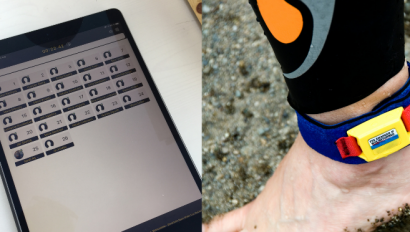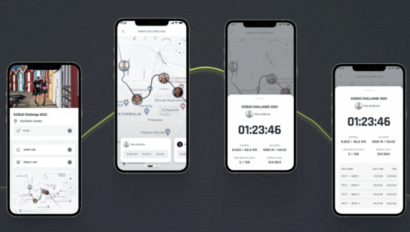How Does an RFID Chip Timing System Work?

In this post, we tell you how chip timing works, and clarify some of the most common chip-timing terminology that is important to know when you educate yourself about your timing options for your race.
Note that this article focuses mostly on chip timing, if you are choosing between App Timing and Chip Timing, read this comparison article that will help you determine which method is right for your race.
If you are looking for Chip Timing hardware or software, you can get a review and comparison table of all the providers available in this post.
This post in video format:
Active and Passive Chip Timing Systems
There are two types of chip timing systems – Active and Passive.
Active systems have larger battery operated chips, where the chip transmits signals to the receivers and decoders (or transponders). Most are intensity-based systems. There are also phased-based systems. In a phase-based active system, transceivers ‘wake-up’ the chip first. Active systems are usually reusable.
Passive systems have a ‘passive’ chip that can be embedded into a number bib for instance. The chip reflects signals. These are then read by transceivers as the chip passes close-by. Passive chips are often disposable.
Essentially, despite the ‘active’ or ‘passive’ nature of the systems, they work in a similar way. Chips are read by a RFID (radio frequency identification) receiver, transponder or transceiver, subsequently decoded and then relayed to the timing software for processing and upload. However in some timing hardware, the data is stored on the chip itself which is then read-out at the finish line. This type of hardware is used in races where remoteness of participants means equipment, transmission and data signal at checkpoints are limiting factors (think remote mountain marathons, adventure races and orienteering, etc)
Other Important Chip Timing Terminology
Receiver. A device that receives electromagnetic signals
Transceiver. A device that both transmits and receives electromagnetic signals
Transponder. A device that receives signals, processes them, and responds in a pre-programmed manner.
Decoder. A device that decodes electromagnetic signals from chips into readable data for software. Often a component of receivers, transceivers and transponders.
RFID. Radio Frequency Identification. The electromagnetic wave or signal sits in the radio-frequency part of the electromagnetic spectrum.
Intensity-based systems (RSSI – Received Signal Strength Intensity). An active timing system that measures the intensity of the received signals to determine the chip whereabouts (a stronger signal intensity correlates with a closer-to-receiver-chip). Usually possible to get an accuracy within 0.2s.
Phased-based systems. A timing system that measures the change in phase of an active electromagnetic signal to determine the position of the chip. This system is more accurate (about an order of magnitude better) than RSSI systems, and is thus common in motor-sport and other races where high-accuracy of lap/finish times is important.
UHF.Ultra High Frequency (a description of the frequency of a electromagnetic wave or signal)
Duel Frequency. Two waves of different (lower) frequency transmitted simultaneously. The longer wavelengths (lower frequency) of emissions mean that this type of chip can send signals through water, mud, humans, etc. Read accuracy is higher due to minimal reflections and smaller range. The read-rate is lower though, when compared with UHF. The cost per chip is more expensive than disposable chips of course, but its flexibility is suited to OCR’s, swims and wet, muddy environments.
NFC chips. NFC (Near Field Communication) is a technology best known in payments (think contactless with your credit card or mobile phone). It is also used in some timing technologies. Participants carry a chip that works as an identifier that can be read by a Near Field transceiver.
Timing App. Usually a digital version of the classic pen/paper/stop-watch. Very cost effective and easy to use (requires no specialist knowledge). Instant results lists. Suitable for smaller size races or longer races whereby participants are spread-out as they pass through checkpoints and across finish lines. Generally requires manual use and accurate to within a second or two (fairly low compared with chip timing). Human related error-rate, but usually easily rectified.
Open Data. This means that the data from the timing chips and receivers is un-encrypted and can be used and transferred between various other platforms as required. If data is not open, it means it can only be read by the proprietary software developed by the company owning the timing systems and hardware. This is obviously less flexible and ties you into a certain system.
Locked System. When the system is locked, it means that everything works only with compatible devices and software. Therefore you will need to use only chips, decoders, readers, mats, etc from that company. The data after the race may or may not be open for transfer. An un-locked system is readable by any unlocked device, regardless of manufacturer.
We hope that clears things out! Don’t forget to check out the comparison chart in this post in case you are looking for a provider.
Did you find this article helpful? For more tips subscribe to our newsletter!


